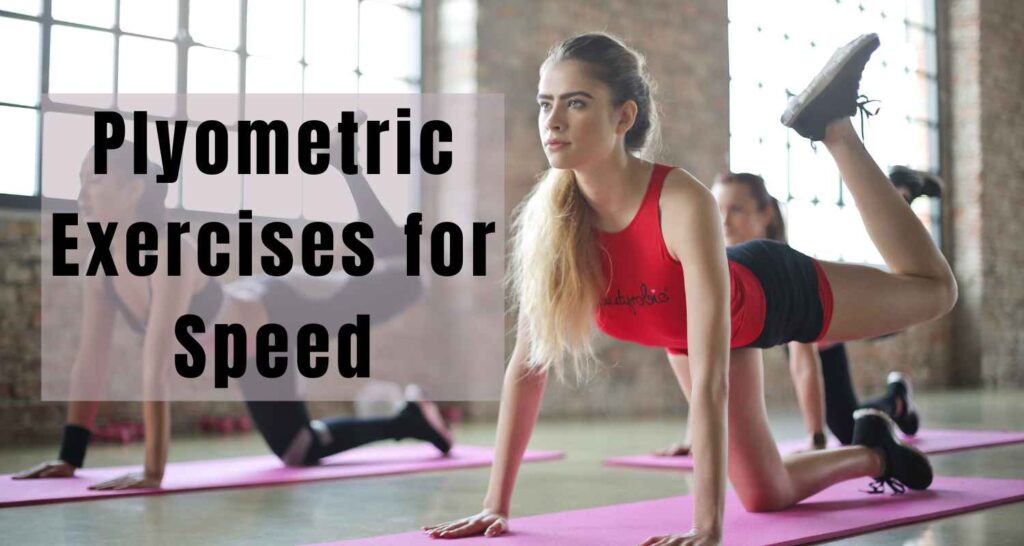Did you know that athletes who incorporate plyometric exercises into their training regimen can experience up to a 17% increase in explosive power and speed?
That’s right, plyometrics, also known as jump training, offers a highly effective way to enhance your agility and take your athletic performance to the next level.
In this article, we will explore the benefits of plyometric exercises for speed and agility. We will delve into plyometric training and its role in developing speed and power.
Additionally, we will provide step-by-step instructions and explanations for a variety of explosive workouts for agility and speed drills that you can incorporate into your routine.
Whether you’re a sprinter looking to shave seconds off your time or a team athlete wanting to gain a competitive edge, plyometric exercises are the key to unlocking your full athletic potential.
Let’s explore plyometric exercises for speed and agility.
Key Takeaways:
- Plyometric exercises can lead to a significant increase in explosive power and speed.
- Jump training is an effective way to enhance agility and athletic performance.
- Plyometric exercises are suitable for sprinters, team athletes, and individuals seeking improved speed and agility.
- Incorporating targeted speed and agility drills into your routine is crucial for optimal results.
- Consult with a professional trainer or coach to ensure safety and proper technique when performing plyometric exercises for speed and agility.
Understanding Plyometric Training for Speed
When it comes to enhancing speed and power, plyometric training is a game-changer for athletes. Plyometric exercises uniquely engage the muscles, helping athletes develop explosive strength and improve their overall athleticism.
In this section, we will dive deep into plyometric training and its role in improving speed and power.
Plyometric training focuses on quick and powerful movements that involve rapid contractions and stretches of the muscles. By utilizing plyometric exercises, athletes can enhance their neuromuscular efficiency, which is crucial for achieving greater speed and agility.
There is a wide range of plyometric exercises for speed that athletes can incorporate into their training routines. These exercises target specific muscle groups and help athletes develop the right combination of strength, speed, and power required for optimal athletic performance.
One popular plyometric exercise for speed and power training is the box jump. This exercise involves explosively jumping onto a raised platform, such as a plyo box or bench, and then quickly jumping back down. Box jumps improve leg power, explosiveness, and reactive strength, making them ideal for athletes looking to enhance their speed and agility.
In addition to box jumps, other plyometric exercises such as squat jumps, tuck jumps, and depth jumps can also be incorporated into a comprehensive training program. These exercises engage multiple muscle groups simultaneously, helping athletes develop the explosive power needed for quick, explosive movements.
Note: Plyometric training can be highly effective for improving speed and power, it also carries a risk of injury if not performed correctly. Athletes should always prioritize proper technique, gradually increase intensity and volume, and ensure adequate rest and recovery between training sessions.
In the next section, we will explore a variety of plyometric exercises for athletes that they can incorporate into their training routines to further enhance their quickness and reaction time.
Effective Speed and Agility Drills
Enhancing speed and agility is crucial for athletes seeking to improve their performance on the field. In this section, we will discuss a variety of agility training exercises and speed and agility drills that can help athletes enhance their quickness, reaction time, and change of direction.
1. Cone Drills: One of the most popular speed and agility drills is the cone drill. Set up a series of cones in a straight line or in a zigzag pattern and sprint between them, focusing on quick acceleration and deceleration.
Pro Tip: Start with a few cones and gradually increase the difficulty by adding more cones or increasing the distance between them.
2. Ladder Drills: Ladder drills are excellent for improving footwork and coordination. Set up an agility ladder on the ground and perform various exercises such as quick steps, side shuffles, and high knees, focusing on maintaining speed and precision.
3. Shuttle Runs: Shuttle runs are a great drill for developing explosive speed and agility. Choose a specific distance, mark two points, and sprint back and forth between them, focusing on quick changes of direction and maximizing acceleration.
Pro tip: Time yourself during shuttle runs to track your progress and challenge yourself to improve your speed and agility.
4. Box Jumps: Box jumps are a plyometric exercise that can help improve burst and power. Find a sturdy box or platform and jump onto it, focusing on explosive and controlled movements. Remember to land softly and bend your knees upon landing to prevent injury.
5. T-Drills: T-drills are excellent for improving agility, change of direction, and coordination. Set up cones in a T-shape pattern and sprint from the starting point to each cone, focusing on quick changes of direction and maintaining speed.
Tailoring Plyometric Exercises for Sprinters
Plyometric exercises play a crucial role in enhancing the explosive power and speed of sprinters on the track. To optimize their performance, sprinters require a tailored approach to plyometric training that focuses on specific muscle groups and movement patterns.
When designing a plyometric training program for sprinters, it is essential to incorporate exercises that replicate the explosive movements involved in sprinting. These exercises should target the lower body muscles, particularly the quadriceps, hamstrings, glutes, and calves.
Here are some plyometric exercises for speed specifically tailored for sprinters:
- Box Jumps: Start with a box that is knee height and jump onto it explosively, landing softly. Repeat for multiple sets and gradually increase the height of the box as your strength and power improve.
- Depth Jumps: Step off a box onto the ground and immediately jump vertically as high as possible. This exercise helps improve reactive strength and enhances sprinting power.
- Single-Leg Bounds: Leap forward explosively on one leg, landing on the opposite leg with control. Alternate legs and focus on maximizing the distance covered with each bound.
- Ankle Hops: Jump forward off one foot while maintaining a fast and continuous movement pattern. This exercise targets the calves and helps improve ankle stability and explosive push-off.
Remember, proper form and technique are crucial when performing plyometric exercises. Always warm up thoroughly before starting your plyometric training and gradually progress the intensity and volume of your workouts.
By incorporating these plyometric exercises into their training routines, sprinters can develop the explosive power and speed needed to excel on the track. Combine these plyometric exercises for speed with other sprint-specific drills and proper rest and recovery to achieve optimal results.
Conclusion
In conclusion, incorporating plyometric exercises into your training routine can significantly improve your speed and agility. These explosive workouts are highly effective in enhancing athletic performance and helping you achieve your speed goals.
When incorporating plyometric drills, it is crucial to prioritize safety and proper technique. Consult with a professional trainer or coach to ensure that you are performing the exercises correctly and avoiding any potential injuries.
Start incorporating plyometric exercises for speed into your training today and unleash your full athletic potential. Whether you’re a sprinter or an athlete looking to improve your overall agility, these exercises can greatly enhance your performance and take your speed to new heights.
FAQs
What are plyometric exercises?
Plyometric exercises, also known as jump training or plyos, are explosive movements that involve quick and powerful muscle contractions. These exercises are designed to improve speed, power, and agility by maximizing the stretch-shortening cycle of the muscles.
How do plyometric exercises improve speed and agility?
Plyometric exercises enhance speed and agility by improving the muscles’ ability to generate force quickly. They also improve neuromuscular coordination, increase muscle power, and enhance elasticity, allowing athletes to accelerate faster, change directions more efficiently, and react quicker in various sports situations.
What are some effective plyometric exercises for speed training?
Some effective plyometric exercises for speed training include squat jumps, box jumps, burpees, tuck jumps, and single-leg hops. These exercises target the lower body muscles, such as the quadriceps, hamstrings, and calf muscles, to enhance explosiveness and speed.
Are plyometric exercises suitable for all athletes?
Plyometric exercises can be beneficial for athletes of various sports and fitness levels. However, it is essential to evaluate each athlete’s readiness for this type of training. Beginners should start with foundational strength and stability exercises before progressing to more advanced and high-impact plyometric exercises.
How often should plyometric exercises be performed?
The frequency of plyometric exercises will depend on an athlete’s training program, goals, and overall workload. Generally, 2-3 sessions per week can be effective for improving speed and agility. It is crucial to include proper rest and recovery periods to avoid overtraining and potential injuries during speed training drills.
Can plyometric exercises help sprinters improve their speed?
Yes, plyometric exercises can be highly beneficial for sprinters. These exercises strengthen the muscles involved in generating explosive power, such as the glutes, quadriceps, and hamstrings. By targeting the specific demands of sprinting, plyometric training can increase stride length, stride frequency, and overall sprinting speed.
Are there any precautions to consider when performing plyometric exercises?
Yes, it is crucial to consider several precautions when performing plyometric exercises. These include selecting a suitable training surface, wearing proper athletic footwear, maintaining proper form and technique, landing softly and quietly to reduce impact forces, and listening to your body to avoid overexertion or injury.
Disclaimer: This content, including advice, provides generic information only. It is not a substitute for a qualified medical opinion. Always consult a specialist or your doctor for more information. Nutrition Cult does not claim responsibility for this information.




